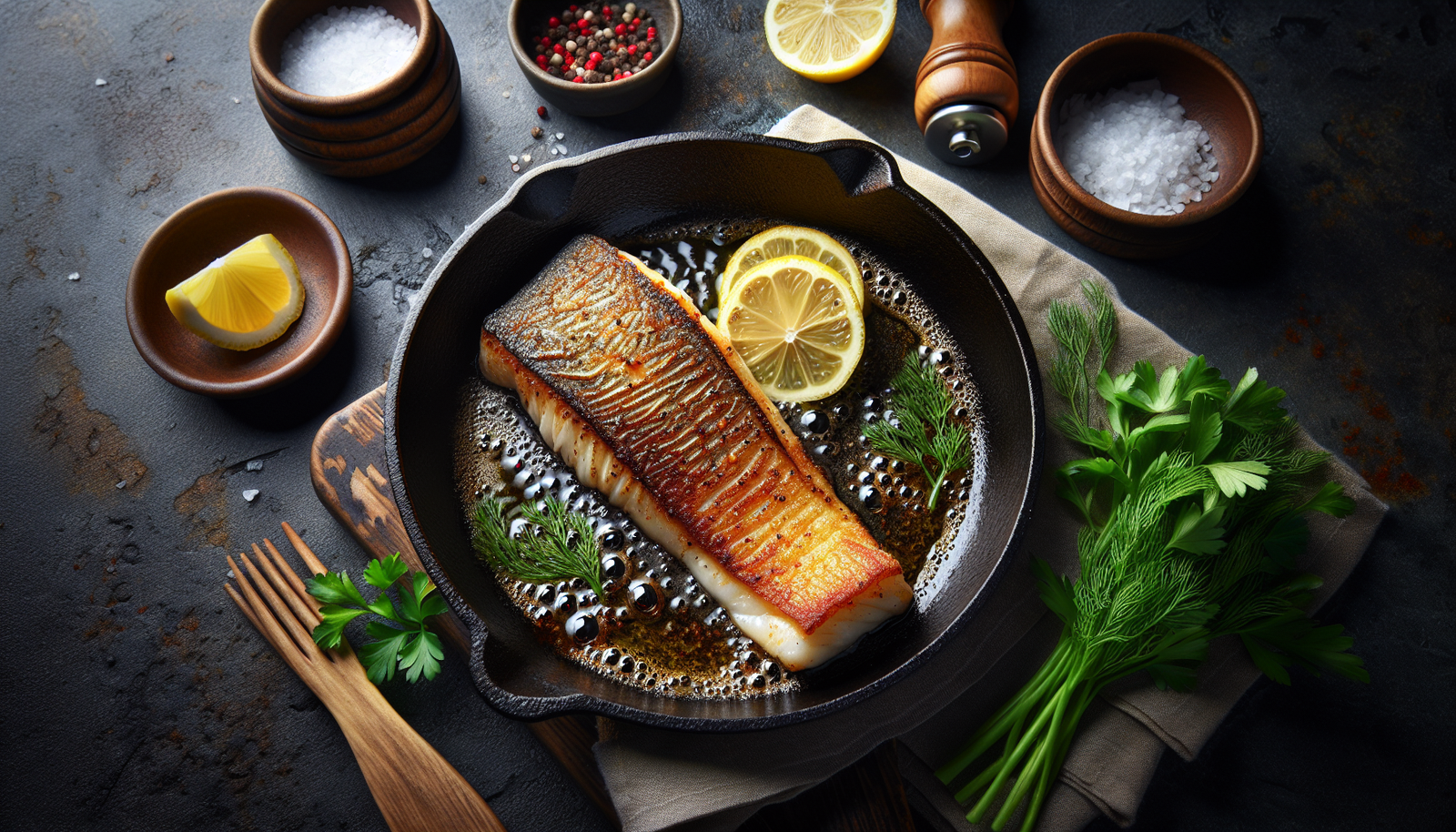
How to Pan-Sear Fish for a Crispy Skin and Tender Fillet
Pan-searing fish is a culinary technique that transforms a simple fillet into a crispy, flavorful delight. The key lies in achieving a perfectly crisp skin while keeping the fish tender and moist. A well-executed pan-sear can enhance the natural flavors of the fish, making it a restaurant-quality dish at home. In this guide, we’ll delve into the step-by-step process of pan-searing fish, from selecting the right type of fish to perfecting the cooking method. Discover tips for achieving that coveted golden-brown crust and learn how to elevate your cooking skills with this essential technique.
Benefits of Pan-Searing Fish for Crispy Skin
Pan-searing fish to achieve a crispy skin is a technique favored by chefs and home cooks alike. This method not only elevates the flavor and texture of the dish but also offers a healthier alternative to deep-frying. Let’s delve into why crispy skin is a game-changer for taste and nutrition.
Why Crispy Skin Enhances Flavor and Texture
The appeal of crispy fish skin lies in its ability to add a satisfying crunch to each bite. This texture contrast enhances the overall dining experience. The process of pan-searing locks in juices, ensuring the fish remains moist and tender inside. The Maillard reaction, a chemical process between amino acids and reducing sugars, occurs when the skin meets a hot pan, creating a rich, savory flavor profile. This reaction is responsible for the golden-brown color and irresistible taste that keeps you coming back for more.
Nutritional Advantages of Pan-Searing Over Deep-Frying
Pan-searing is a healthier cooking method compared to deep-frying. This technique requires less oil, which reduces the overall calorie content of the dish. Additionally, the type of oil used can further enhance the nutritional value. Opting for healthy oils such as olive or avocado oil provides beneficial fats while minimizing unhealthy trans fats. This approach maintains the fish’s natural nutrients, ensuring you receive essential omega-3 fatty acids, vitamins, and minerals without added unhealthy components.
Quick Cooking Method for a Healthy Meal
In today’s fast-paced world, time-efficient cooking methods are highly valued. Pan-searing fish is a quick process, often taking less than 10 minutes. This speed does not compromise the quality or flavor of the meal. The rapid cooking time helps preserve the fish’s nutrients, making it an ideal choice for a healthy dinner. Furthermore, this method is versatile and can be easily adjusted to fit various types of fish and seasoning preferences, allowing for a variety of healthy meals.
Essential Tools and Ingredients for Perfectly Pan-Seared Fish
Achieving perfectly pan-seared fish requires more than just skill. The right tools and ingredients are crucial in enhancing the flavor and ensuring the skin crisps to perfection. Understanding the essentials can transform your cooking experience and results.
Choosing the Right Pan for Pan-Searing Fish
The pan is a key player in pan-searing fish. A good quality non-stick or cast-iron skillet is ideal. These pans distribute heat evenly, crucial for achieving a uniform crispy skin. A heavy-bottomed pan retains heat well, reducing the risk of hot spots that can cause uneven cooking. Ensure your pan is preheated to the right temperature before adding the fish to prevent sticking and to start the Maillard reaction instantly.
Best Types of Fish for Crispy Skin Texture
Not all fish are created equal when it comes to achieving crispy skin. Certain types, such as salmon, seabass, and snapper, are perfect for pan-searing due to their firm texture and rich skin. These fish types have a higher fat content, which enhances flavor and helps the skin crisp better. Choosing the right fish ensures the best possible results in both taste and texture.
Importance of Seasoning and Oil Selection
Seasoning and oil choice are pivotal in pan-searing fish. A simple seasoning of salt and pepper can accentuate the fish’s natural flavors. However, adding herbs or spices can provide a unique twist. The oil used should have a high smoke point to withstand the high heat of pan-searing. Oils like grapeseed, avocado, or canola are excellent choices. Using the right oil ensures the skin crisps up nicely without burning.
Step-by-Step Guide to Pan-Searing Fish
Pan-searing fish to perfection involves more than just throwing it into a hot pan. It requires preparation, precision, and the right technique. Follow this guide to achieve a dish that is both visually appealing and deliciously satisfying.
Preparing the Fish for Optimal Cooking Results
Preparation is key to a successful pan-sear. Start by patting the fish dry with a paper towel. Removing excess moisture is crucial as it prevents steaming and ensures the skin crisps up. Season the fish generously, focusing on the skin side for maximum flavor. Allow the fish to reach room temperature before cooking to promote even heat distribution.
Technique for Achieving Crispy Skin and Tender Fillet
Mastering the technique of pan-searing involves careful attention to detail. Begin by preheating your pan on medium-high heat. Add a small amount of oil, swirling it to coat the pan evenly. Place the fish skin-side down, pressing gently for even contact. Avoid flipping too soon; let the skin crisp for several minutes. A gentle press with a spatula can help maintain contact. Once the skin is golden and releases easily, flip the fish to finish cooking the other side.
Tips for Avoiding Common Pan-Searing Mistakes
Pan-searing fish can be tricky, with common pitfalls that can affect the outcome. Avoid overcrowding the pan, which can lead to steaming instead of searing. Ensure the pan is hot enough before adding the fish to prevent sticking. Keep an eye on the oil’s smoke point to avoid burning it. Lastly, resist the urge to move the fish too often; patience is key to achieving a perfect sear.
Conclusion
Pan-searing fish involves cooking it quickly in a hot pan to create a crisp exterior. The process starts by patting the fish dry to ensure even browning. Seasoning the fish with salt and pepper enhances its flavor. Using oil with a high smoke point, like canola or vegetable oil, helps achieve a good sear. Cooking time is brief, usually just a few minutes per side, depending on the thickness of the fish.
FAQ
What are the best types of fish for pan-searing?
Firm, white-fleshed fish like halibut, cod, and sea bass are excellent choices for pan-searing. Their structure holds up well, creating a delicious, crispy crust.
How do I prevent fish from sticking to the pan when searing?
Ensure the pan is hot before adding the fish. A light coating of oil and a non-stick or well-seasoned skillet can also help prevent sticking.
What is the ideal searing time for fish in a pan?
Typically, sear fish for 3-4 minutes on each side. Thicker cuts may require slightly longer cooking times, so adjust accordingly.
How can I tell when pan-seared fish is cooked to perfection?
Cooked fish should easily flake with a fork and have an opaque appearance. Internal temperatures should reach around 145°F for optimal doneness.
Can I use olive oil for pan-searing fish, or are there better alternatives?
Olive oil works well for pan-searing, lending a rich flavor. However, oils with higher smoke points like canola or grapeseed are excellent alternatives.
What seasonings enhance the flavor of pan-seared fish?
Common seasonings include sea salt, black pepper, garlic powder, and lemon zest. Fresh herbs like dill or parsley add vibrant taste to the dish.











